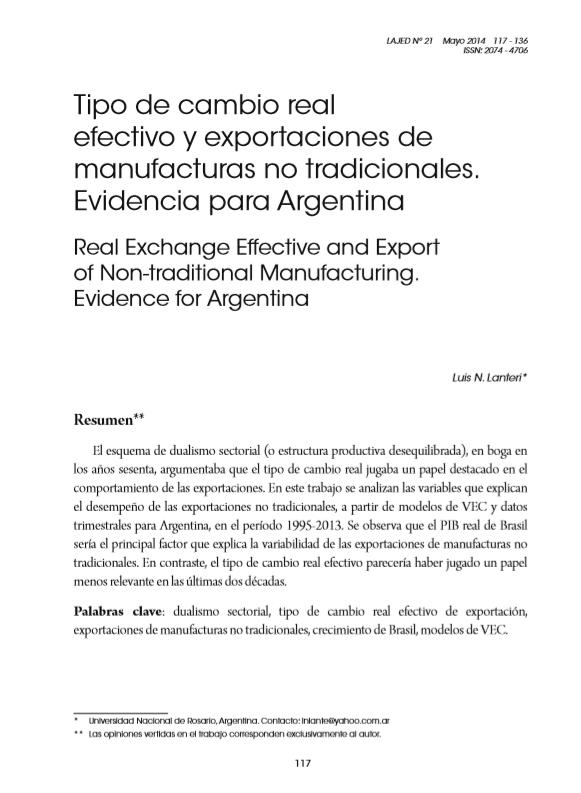Real Exchange Effective and Export of Non-traditional Manufacturing. Evidence for Argentina
DOI:
https://doi.org/10.35319/lajed.20142197Keywords:
sectorial dualism, real effective exchange rate for exports, nontraditional manufacturing exports,, Brazil growth, VEC modelsAbstract
Sectorial dualism scheme (or unbalanced productive structure), in vogue in the sixties, argued that the real exchange rate played a prominent role in the behavior of exports. In this paper, we analyze the variables which explain nontraditional export performance, from VEC models and quarterly data for Argentina, covering the period 1995-2013. It is noted that real GDP of Brazil would be the main factor explaining variability of nontraditional manufacturing exports. In contrast, the real effective exchange rate seems to have played a smaller role in the last two decades.
Downloads
References
Braun, O. y Joy, L. (1968). “A Model of Economic Stagnation. A Case Study of the Argentine Economy”. The Economic Journal. 78 (312), 868-87.
Bresser-Pereira, L. (2008). “The Dutch Disease and its Neutralization: a Ricardian Approach”. Brazilian Journal of Political Economy. 28 (1), 47-71.
Canitrot, A. (1975). “La experiencia populista de redistribución de ingresos”. Desarrollo Económico. 15 (59), 331-51.
Catao, L y Falcetti, E. (2002). “Determinants of Argentina’s External Trade”. Journal of Applied Economics 5 (1), 19-57.
CENDA. (2006). “El boom exportador de la Argentina: ¿qué hay de nuevo?”. Notas de la economía argentina. Edición 01. Buenos Aires. Junio.
Diamand, M. (1972). “La estructura productiva desequilibrada argentina y el tipo de cambio”. Desarrollo Económico. 12 (45), 1-24.
Díaz Alejandro, C.(1963). “A Note on the Impact of Devaluation and the Redistributive Effect”. Journal of Political Economy. 71 (6), 577-80.
Díaz Alejandro, C. (1970). Ensayos sobre la historia económica argentina. Buenos Aires: Amorrortu editores.
Díaz Alejandro, C. (1981). “Tipo de cambio y términos de intercambio en la Argentina, 1913-1976”. CEMA. Serie Documentos de Trabajo, Nº 22.
Frankel, J. (2010). “The Natural Resource Curse: a Survey”. Harvard Kennedy School. Faculty Research Working Paper Series. RWP10-005. Febrero.
Gala, P. (2007). “Real Exchange Rate Levels and Economic Development: theoretical Analysis and Econometric Evidence”. Cambridge Journal of Economics. 32 (2), 273- 88.
Gluzmann, P., Levy-Yeyati, E. y Sturzenegger, F.(2007). “Exchange Rate Undervaluation and Economic Growth: Díaz Alejandro (1965) Revisited”. Kennedy School of Government, Harvard University.
Heymann, D. (2013). “La inflación y la falta de estadísticas atentan contra el crédito”. en: http://www.cronista.com/economiapolitica/La-inflacion-y-la-falta-deestadisticas-atentancontra-el-credito-20130114-0031.html
Johansen, S.(1988). “Statistical Analysis of Cointegration Vectors”. Journal of Economic Dynamics and Control. 12 (2-3), 231-54.
Johansen, S. y Juselius, K. (1990). “Maximum Likelihood Estimation and Inference on Cointegration-with Application to the Demand for Money”. Oxford Bulletin of Economics and Statistics. (52). 169-210.
Jones, B. y Olken, B. (2005). “The Anatomy of Start-Stop Growth”. NBER Working Paper Nº 11528. Cambridge MA.
Lütkepohl, H.(1991). “Introduction to Multiple Time Series Analysis”. Berlin: Springer Verlag.
Mallon, R. y Sourrouille, J. (1975). “Economic Policymaking in a Conflict Society”. Cambridge, Mass.: Harvard University Press.
Morgenroth, E. (2000). “Exchange Rates and Trade: the Case of Irish Exports to Britain”.Applied Economics. 32 (1). 107-110.
Mundlak, Y., Cavallo, D. y Doménech, R.(1989). “Agriculture and Economic Growth in Argentina, 1913-84”. IFPRI. Research Report 76.
Nicolini-Llosa, J.(2007). “Essays on Argentina’s Growth Cycle and the World Economy”. PhD Dissertation. University of Amsterdam.
Nicolini-Llosa, J. (2011). “Dual Equilibrium and Growth Cycle in Argentina”. International Review of Applied Economics. 25 (2). 185-207.
Panigo, D., Chena, P. y Gárriz, A. (2010). “Efectos de la estructura productiva desequilibrada y de los esquemas cambiarios sobre el ciclo del empleo en la Argentina”. Ensayos económicos. (59). 3-51.
Rodrik, D.(2008). “The Real Exchange Rate and Economic Growth”. Brookings Papers on Economic Activity. (39), 365-439.
Villanueva, J. (1964). “Problemas de industrialización con restricciones en el sector externo”. Desarrollo Económico. 4 (14-15). 171-82.






